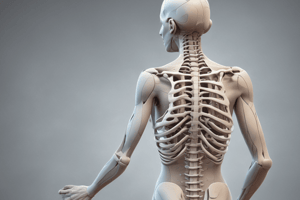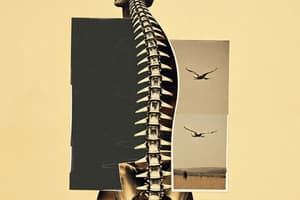Podcast
Questions and Answers
What percentage of scoliosis cases are idiopathic?
What percentage of scoliosis cases are idiopathic?
- Almost 100%
- Less than 10%
- More than 50% (correct)
- About 20%
Which of the following is NOT a symptom of scoliosis?
Which of the following is NOT a symptom of scoliosis?
- Uneven shoulder height
- Leg length discrepancy
- Difficulty breathing
- Fever (correct)
What is the primary purpose of X-rays in diagnosing scoliosis?
What is the primary purpose of X-rays in diagnosing scoliosis?
- To rule out other conditions
- To measure the degree of curvature (correct)
- To identify genetic mutations
- To monitor the progression of the condition
Which exercise therapy is specifically designed to improve posture, strengthen muscles, and reduce curvature?
Which exercise therapy is specifically designed to improve posture, strengthen muscles, and reduce curvature?
What is the main goal of bracing in scoliosis treatment?
What is the main goal of bracing in scoliosis treatment?
Which of the following is a neuromuscular condition that can cause scoliosis?
Which of the following is a neuromuscular condition that can cause scoliosis?
What is the primary purpose of physical examination in diagnosing scoliosis?
What is the primary purpose of physical examination in diagnosing scoliosis?
Which of the following is a common symptom of severe scoliosis?
Which of the following is a common symptom of severe scoliosis?
Flashcards are hidden until you start studying
Study Notes
Causes of Scoliosis
- Genetic predisposition: Family history and genetic mutations can increase the risk of developing scoliosis.
- Neuromuscular conditions: Conditions such as cerebral palsy, spina bifida, and muscular dystrophy can cause scoliosis.
- Congenital: Birth defects, such as spina bifida, can cause scoliosis.
- Idiopathic: The majority of scoliosis cases are idiopathic, meaning the cause is unknown.
Symptoms of Scoliosis
- Visible signs:
- Uneven shoulder height or shoulder blade prominence
- One shoulder blade sticking out more than the other
- Uneven waistline or hip alignment
- Physical symptoms:
- Back pain
- Fatigue
- Difficulty breathing (in severe cases)
- Other symptoms:
- Leg length discrepancy
- Rib cage deformity
Diagnosis of Scoliosis
- Physical examination: A doctor will examine the patient's back, looking for signs of scoliosis such as uneven shoulder height or rib cage deformity.
- Imaging tests:
- X-rays: To confirm the diagnosis and measure the degree of curvature.
- MRI or CT scans: To rule out other conditions that may be causing similar symptoms.
Treatment Options for Scoliosis
- Observation: Regular check-ups to monitor the progression of the condition.
- Bracing: Wearing a back brace to prevent further curvature.
- Surgery: Spinal fusion surgery to straighten the spine.
- Physical therapy: Exercise and stretching to improve flexibility and strength.
Exercise Therapy for Scoliosis
- Schroth method: A specific exercise program designed to improve posture, strengthen muscles, and reduce curvature.
- Yoga and Pilates: Gentle exercises to improve flexibility, balance, and core strength.
- Strengthening exercises: Targeted exercises to strengthen the muscles that support the spine.
- Breathing exercises: Exercises to improve lung capacity and reduce respiratory symptoms.
Causes of Scoliosis
- Genetic mutations and family history increase the risk of developing scoliosis
- Neuromuscular conditions, such as cerebral palsy, spina bifida, and muscular dystrophy, can cause scoliosis
- Congenital birth defects, such as spina bifida, can cause scoliosis
- Idiopathic scoliosis, with unknown causes, accounts for the majority of cases
Symptoms of Scoliosis
- Visible signs of scoliosis include uneven shoulder height, shoulder blade prominence, and uneven waistline or hip alignment
- Physical symptoms include back pain, fatigue, and difficulty breathing in severe cases
- Other symptoms include leg length discrepancy and rib cage deformity
Diagnosis of Scoliosis
- Physical examination involves examining the back for signs of scoliosis
- Imaging tests, such as X-rays, are used to confirm the diagnosis and measure the degree of curvature
- MRI or CT scans are used to rule out other conditions that may be causing similar symptoms
Treatment Options for Scoliosis
- Observation involves regular check-ups to monitor the progression of the condition
- Bracing involves wearing a back brace to prevent further curvature
- Surgery, specifically spinal fusion, is used to straighten the spine
- Physical therapy, including exercise and stretching, improves flexibility and strength
Exercise Therapy for Scoliosis
- The Schroth method is a specific exercise program designed to improve posture, strengthen muscles, and reduce curvature
- Yoga and Pilates improve flexibility, balance, and core strength
- Strengthening exercises target the muscles that support the spine
- Breathing exercises improve lung capacity and reduce respiratory symptoms
Studying That Suits You
Use AI to generate personalized quizzes and flashcards to suit your learning preferences.




